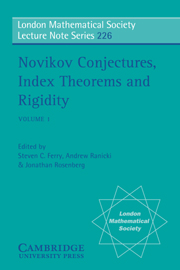Geometric reflections on the Novikov conjecture
Published online by Cambridge University Press: 07 May 2010
Summary
Abstract. The simplest manifestation of rough geometry in the Novikov conjecture appears when one looks at a fiberwise rough (coarse) equivalence between two vector bundles over a given base, where the fibers are equipped with metrics of negative curvature. Such an equivalence induces a fiberwise homeomorphism of the associated sphere bundles and hence, by Novikov's theorem, an isomorphism of the rational Pontrjagin classes of the bundles.
What is relevant of the negative curvature, as we see it nowadays, is a certain largeness of such spaces. More generally, if Xn is a contractible manifold admitting a cocompact group of isometries (or more general uniformly contractible space) one expects it to be rather large in many cases, e.g. admitting a proper Lipschitz map into ℝn of non-zero degree. An example of an X without such maps to ℝn may eventually lead to a counterexample to the Novikov conjecture. On the other hand, there is a growing list of spaces where such a map is available.
A purely analytico-geometric counterpart of the Novikov conjecture for X is the claim that the non-reduced L2-cohomology L2H*(X) does not vanish. A similar conjecture can be stated for the Dirac operator (instead of the de Rham complex): the square of the Dirac operator on X contains zero in its spectrum. Both properties express the idea of the “spectral largeness” of X, and the latter is closely related to the non-existence of a metric with positive scalar curvature quasi-isometric to X.
- Type
- Chapter
- Information
- Novikov Conjectures, Index Theorems, and RigidityOberwolfach 1993, pp. 164 - 173Publisher: Cambridge University PressPrint publication year: 1995
- 4
- Cited by

